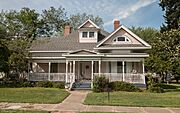Hubbard, Texas facts for kids
Quick facts for kids
Hubbard, Texas
|
|
|---|---|

Buildings in downtown Hubbard
|
|

Location of Hubbard, Texas
|
|
 |
|
| Country | United States |
| State | Texas |
| County | Hill |
| Area | |
| • Total | 1.99 sq mi (5.17 km2) |
| • Land | 1.96 sq mi (5.07 km2) |
| • Water | 0.04 sq mi (0.10 km2) |
| Elevation | 633 ft (193 m) |
| Population
(2020)
|
|
| • Total | 1,394 |
| • Density | 700.5/sq mi (269.6/km2) |
| Time zone | UTC-6 (Central (CST)) |
| • Summer (DST) | UTC-5 (CDT) |
| ZIP code |
76648
|
| Area code(s) | 254 |
| FIPS code | 48-35180 |
| GNIS feature ID | 2410799 |
Hubbard is a small city located in Hill County, Texas, in the United States. It was named after Richard B. Hubbard, who was a governor of Texas. The city is about 42 miles northeast of Waco. In 2020, about 1,394 people lived there.
Contents
History of Hubbard
Hubbard got its name from Richard B. Hubbard, who was the 16th governor of Texas. He was there when the first town lots were sold on August 11, 1881. The city grew when railroads were built through this part of Texas. Hubbard's first bank opened in 1881.
In 1895, something special was found in Hubbard: mineral water. This discovery led to the building of several bath houses and a special health center called a sanitarium. People thought the mineral water was good for their health. Because of this, Hubbard became known as a health resort, and more people moved there.
On March 10, 1973, a very strong tornado hit Hubbard. It destroyed about one-third of the city. Half of the main business area was also damaged. Sadly, six people died, and 77 others were hurt.
Where is Hubbard?
Hubbard is in the southeastern part of Hill County. Texas State Highway 31 goes right through the middle of the city. This highway can take you northeast to Corsicana (about 26 miles away) or southwest to Waco (about 29 miles away).
Another road, State Highway 171, crosses Highway 31 in Hubbard. It goes northwest to Hillsboro, which is the main town of Hill County, about 24 miles away. If you go southeast on Highway 171, you'll reach Mexia, about 23 miles from Hubbard.
The United States Census Bureau says that Hubbard covers a total area of about 1.99 square miles (5.2 square kilometers). Most of this is land, with a small part, about 0.04 square miles (0.1 square kilometers), being water.
People in Hubbard
The population of Hubbard has changed over the years. Here's how many people have lived there during different census counts:
| Historical population | |||
|---|---|---|---|
| Census | Pop. | %± | |
| 1890 | 894 | — | |
| 1900 | 1,608 | 79.9% | |
| 1910 | 1,843 | 14.6% | |
| 1920 | 2,072 | 12.4% | |
| 1930 | 1,855 | −10.5% | |
| 1940 | 1,871 | 0.9% | |
| 1950 | 1,768 | −5.5% | |
| 1960 | 1,628 | −7.9% | |
| 1970 | 1,572 | −3.4% | |
| 1980 | 1,676 | 6.6% | |
| 1990 | 1,589 | −5.2% | |
| 2000 | 1,586 | −0.2% | |
| 2010 | 1,423 | −10.3% | |
| 2020 | 1,394 | −2.0% | |
| U.S. Decennial Census | |||
Hubbard's Population in 2020
In 2020, the 2020 United States census counted 1,394 people living in Hubbard. There were 553 households and 369 families.
The people living in Hubbard came from different backgrounds:
| Race | Number | Percentage |
|---|---|---|
| White (NH) | 903 | 64.78% |
| Black or African American (NH) | 267 | 19.15% |
| Native American or Alaska Native (NH) | 12 | 0.86% |
| Asian (NH) | 5 | 0.36% |
| Some Other Race (NH) | 2 | 0.14% |
| Mixed/Multi-Racial (NH) | 56 | 4.02% |
| Hispanic or Latino | 149 | 10.69% |
| Total | 1,394 |
Education in Hubbard
Students in Hubbard go to schools that are part of the Hubbard Independent School District.
Famous People from Hubbard
Some notable people have come from Hubbard:
- Mark English – a well-known illustrator and painter.
- Samuel D. Johnson, Jr. – a judge for the federal government.
- J. Frank Norris – a fundamentalist Baptist pastor.
- Ron Shanklin – a professional football player (wide receiver) in the NFL.
- Tris Speaker – a famous baseball player who is in the Baseball Hall of Fame.
Photo gallery
See also
 In Spanish: Hubbard (Texas) para niños
In Spanish: Hubbard (Texas) para niños









